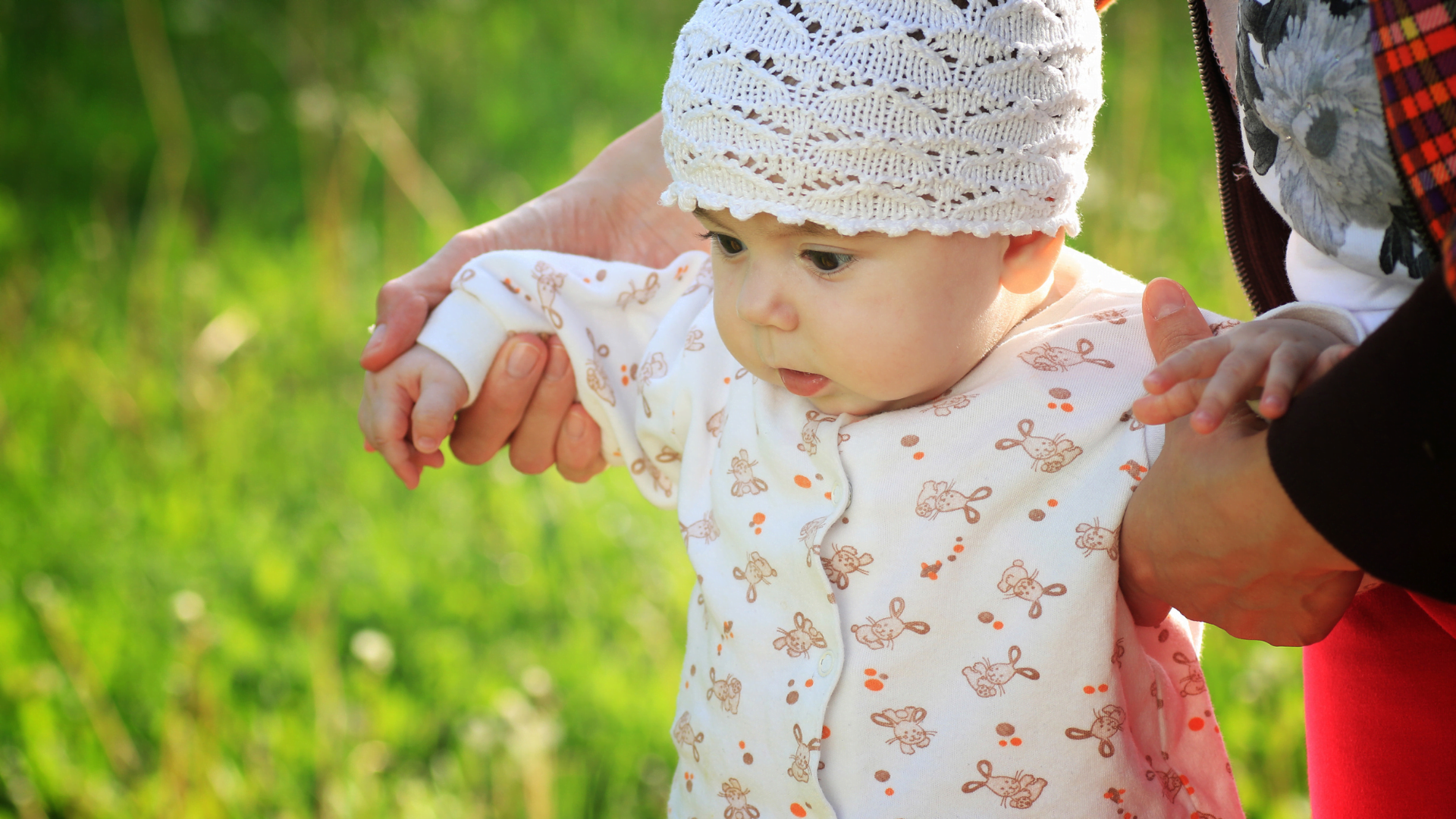Baby Walking ,Watching a baby take their first steps is one of the most exciting milestones for any parent. It’s a sign of growing independence and development. Here are 10 essential things to know about baby walking:
1. Timing Varies
Babies typically start walking between 9 and 18 months, but this can vary widely. Some may walk earlier, while others might take a bit longer. Each baby develops at their own pace.
2. Crawling First
Before walking, most babies go through stages of rolling, sitting, and crawling. Crawling helps strengthen the muscles needed for walking and improves coordination.
3. Standing and Cruising
Before taking their first independent steps, babies often stand while holding onto furniture (cruising). This helps them practice balance and leg strength.
4. Barefoot is Best
Allowing babies to walk barefoot helps them develop better balance and coordination. It also helps their feet muscles strengthen naturally. Shoes are best used for protection when outdoors.
5. Support and Encouragement
Encourage walking by offering support and enthusiasm. Hold their hands as they practice taking steps, and provide praise to build their confidence.
6. Safety First
Ensure your home is safe for a walking baby. Remove sharp objects, cover corners, and use baby gates to prevent falls down stairs. Keep an eye on any potential hazards.
7. Milestone Variation
Each baby reaches milestones at their own rate. Don’t worry if your baby walks later than others. Some babies focus on other skills first, like talking or fine motor activities.
8. Walking Patterns
It’s common for new walkers to have a wide stance and wobbly gait. This is part of learning balance. As they gain confidence, their walking pattern will become more stable and narrow.
9. Encouraging Movement
Create a safe and engaging environment for your baby to explore. Toys that encourage pulling up and cruising can be helpful, such as push toys or activity tables.
10. Regular Check-Ups
Regular pediatrician visits can help ensure your baby is meeting developmental milestones. If you have concerns about your baby’s walking, don’t hesitate to discuss them with your doctor.
Bonus Tips for Parents
- Patience is Key: Every baby learns to walk at their own pace. Be patient and provide plenty of opportunities for practice.
- Celebrate Milestones: Celebrate each small step your baby takes towards walking. It’s a big achievement for them!
- Comfortable Clothing: Dress your baby in comfortable clothing that doesn’t restrict movement. Avoid overly tight or slippery shoes.
- Stay Calm: Babies often fall when learning to walk. Stay calm and offer reassurance to help them build confidence.
Conclusion
- Watching your baby take their first steps is a moment of immense pride and joy. Understanding the process of baby walking can help you support and encourage your child through this important developmental stage.
- Remember, each baby is unique, and they will walk when they are ready. Enjoy this special time and the adventures that come with your little one’s newfound mobility.
What you need to know about baby walkers?

Baby walkers are popular devices that allow infants to move around independently before they can walk on their own. While they might seem like a fun and helpful tool, it’s important to understand both the benefits and risks associated with their use. Here’s what you need to know about baby walkers:
1. Purpose of Baby Walkers
Baby walkers are designed to give babies who cannot walk on their own the ability to move around with the help of wheels. They typically consist of a frame with a seat and leg holes, allowing the baby to sit and use their feet to push off the ground.
2. Developmental Concerns
Contrary to popular belief, baby walkers do not help babies learn to walk sooner. In fact, they can delay motor skill development because they allow babies to move without developing the necessary muscle strength and coordination.
3. Safety Risks
Baby walkers can be dangerous. They allow babies to move quickly and reach potentially hazardous areas like stairs, kitchens, and bathrooms, increasing the risk of falls and injuries. According to the American Academy of Pediatrics (AAP), baby walkers cause thousands of injuries each year.
4. Regulatory Stance
Due to safety concerns, the AAP has called for a ban on baby walkers with wheels. In Canada, the sale of baby walkers has been banned since 2004. Parents are encouraged to consider safer alternatives for mobility.
5. Supervision Requirements
If you choose to use a baby walker, constant supervision is essential. Never leave a baby unattended in a walker, even for a moment, as they can quickly get into dangerous situations.
6. Alternative Options
There are safer alternatives to baby walkers that encourage development without the associated risks. Stationary activity centers, play mats, and push toys help babies develop motor skills in a safer environment.
7. Usage Limitations
If a baby walker is used, it should be for short periods and on a flat, stable surface away from stairs and other hazards. Ensure that all safety features, like brakes and safety harnesses, are functioning properly.
8. Age and Weight Limits
Follow the manufacturer’s guidelines regarding age and weight limits. Baby walkers are typically designed for babies who can sit up unassisted and weigh between 15 and 26 pounds.
9. Consumer Product Safety
Check for recalls and safety warnings from organizations such as the Consumer Product Safety Commission (CPSC). Ensure the walker meets current safety standards and is free from defects.
10. Parental Education
Educate yourself on the pros and cons of baby walkers. Understanding the potential risks and benefits can help you make an informed decision about whether a walker is appropriate for your child.
Conclusion
- While baby walkers may seem like a fun and convenient way to help your baby move around, they come with significant risks that can outweigh the benefits. Safety concerns, potential developmental delays, and the need for constant supervision make baby walkers a controversial choice.
- Consider safer alternatives that encourage mobility and motor skill development without the associated hazards. If you do decide to use a walker, ensure you follow all safety guidelines and keep a close watch on your little one at all times.
What are the signs that a baby is about to walk?Baby Walking
Watching a baby take their first steps is an exciting milestone for any parent. While every baby develops at their own pace, there are common signs that indicate your little one is getting ready to walk. Here are some key indicators:
1. Pulling Up to Stand
One of the first signs that a baby is preparing to walk is pulling themselves up to a standing position using furniture, people, or other objects. This shows they are developing the leg strength and balance needed for walking.
2. Cruising
Cruising refers to a baby walking while holding onto furniture for support. This helps them practice balance and coordination while moving sideways or along the edges of furniture.
3. Standing Without Support
A baby who can stand without holding onto anything is developing the balance and muscle control necessary for walking. Even if it’s just for a few seconds, this is a positive sign that walking is near.
4. Taking Steps with Support
Babies often start by taking steps while holding onto a caregiver’s hands or using a push toy. This helps them gain confidence and practice the motion of walking while still having some support.
5. Improved Balance
Noticeable improvements in balance, such as being able to squat down and stand back up without falling, indicate that a baby is gaining the stability needed for independent walking.
6. Exploring New Movements
Babies who are close to walking often experiment with different movements, such as shifting their weight from one leg to the other, bouncing on their legs, or even trying to take a step and catching themselves.
7. Increased Mobility
A baby who is eager to move and explore their environment is likely getting ready to walk. This includes crawling quickly, climbing, and showing curiosity about their surroundings.
8. Confidence in Letting Go
If a baby starts to let go of furniture and stands independently, even for brief moments, it’s a sign they are building the confidence needed to take those first steps.
9. Strengthened Leg Muscles
Noticeable muscle development in a baby’s legs and the ability to bear more weight on their legs are indicators that they are physically preparing for walking.
10. Attempting to Walk
Sometimes, babies will take a step or two on their own before falling down. These initial attempts, even if wobbly, show that they are practicing and getting ready for more consistent walking.
Tips to Encourage Walking
- Provide Safe Spaces: Create a safe environment where your baby can practice standing, cruising, and walking without the risk of injury.
- Encourage Movement: Place toys or objects of interest just out of reach to motivate your baby to move towards them.
- Offer Support: Hold your baby’s hands and help them take steps, or use push toys that provide stability.
- Be Patient: Every baby walks at their own pace. Encourage and support your baby without rushing them.
Conclusion
- Recognizing the signs that a baby is about to walk can help parents provide the right support and encouragement during this important developmental stage.
- From pulling up to stand and cruising along furniture to standing independently and taking those first steps, each sign indicates that your baby is building the strength, balance, and confidence needed to walk.
- Celebrate each milestone and provide a safe, supportive environment to help your little one on their journey to walking.
